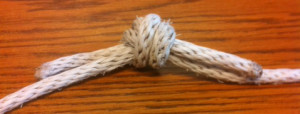 What could be simpler than tying two overhand knots to form a water knot? Its use goes back to commercial fisherman who needed to tie the ends of two wet fishing lines together.
What could be simpler than tying two overhand knots to form a water knot? Its use goes back to commercial fisherman who needed to tie the ends of two wet fishing lines together.
To tie two ropes together of man-made fiber, it’s a simple knot with little bulk and above all, it’s a knot that will not fail. In pioneering, whenever you’re using ropes made of man-made fibers that are braided and slick and don’t hold knots well, think of the water knot.
Begin the water knot by tying a loose overhand knot in the end of one rope, then bring the end of the other rope over and under the first overhand knot, following the same path in reverse.
PIONEERING — USES
- To tie together the ends of two wet or slippery ropes.
- To make a grommet (loop) using all types of rope (braided or twisted). Keep in mind that once strain is put on the knot, it will be hard to untie.
- To tie together the ends of halyards.
- To tie the ends of flat nylon webbing to make a grommet (loop) or sling.
